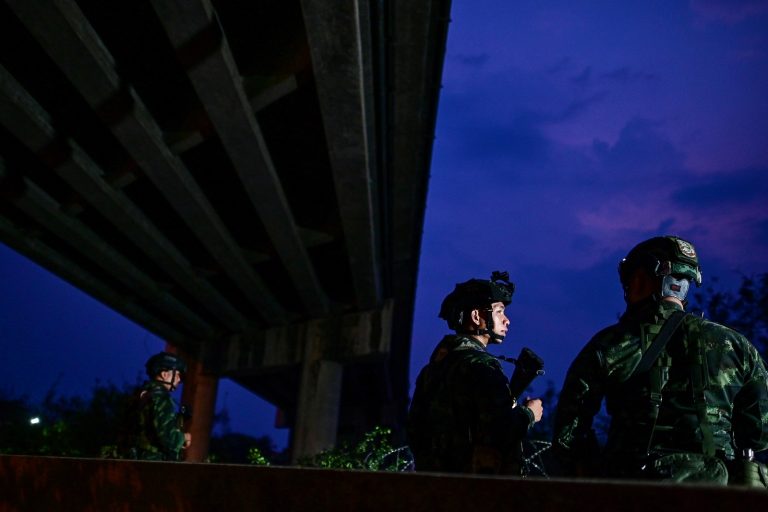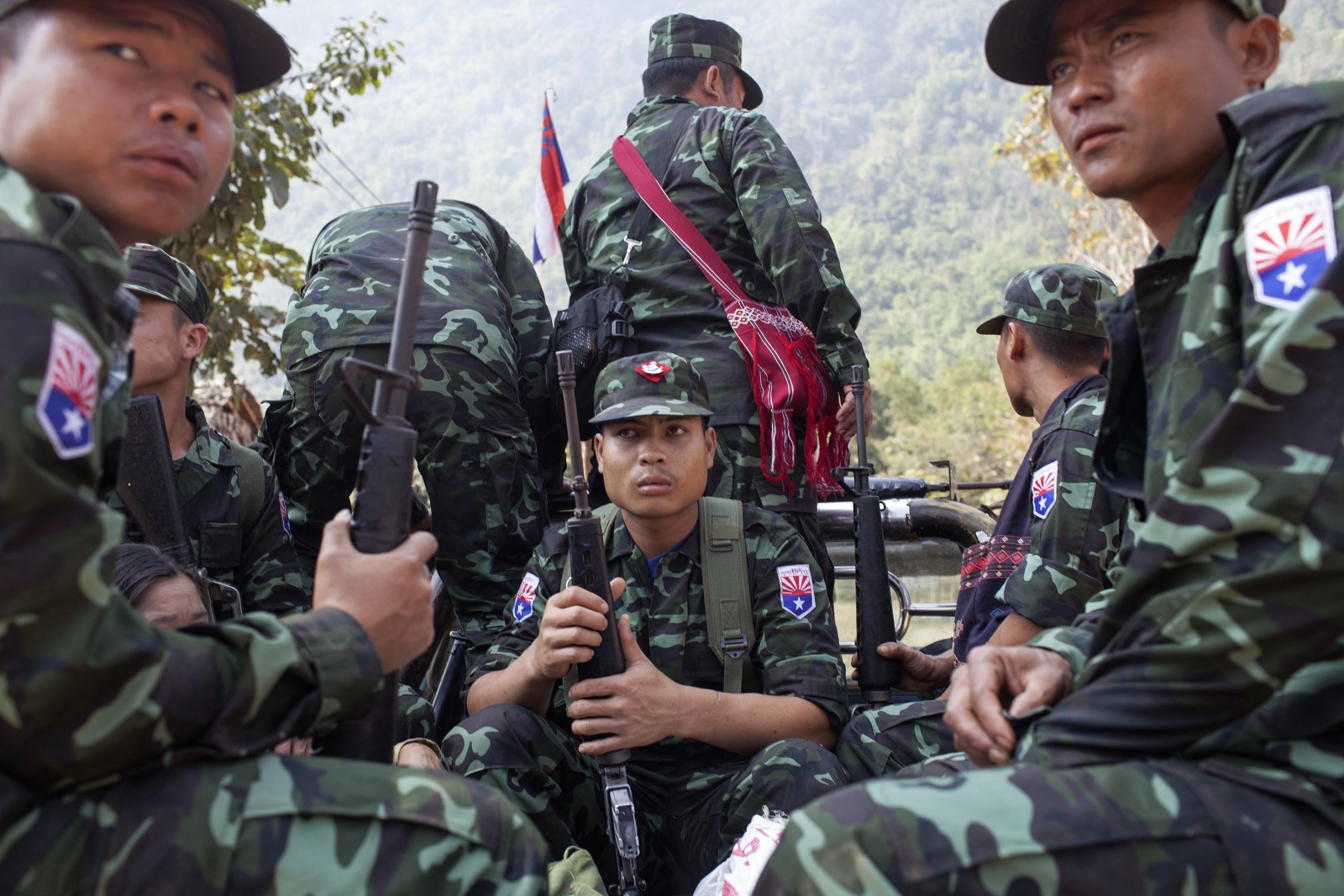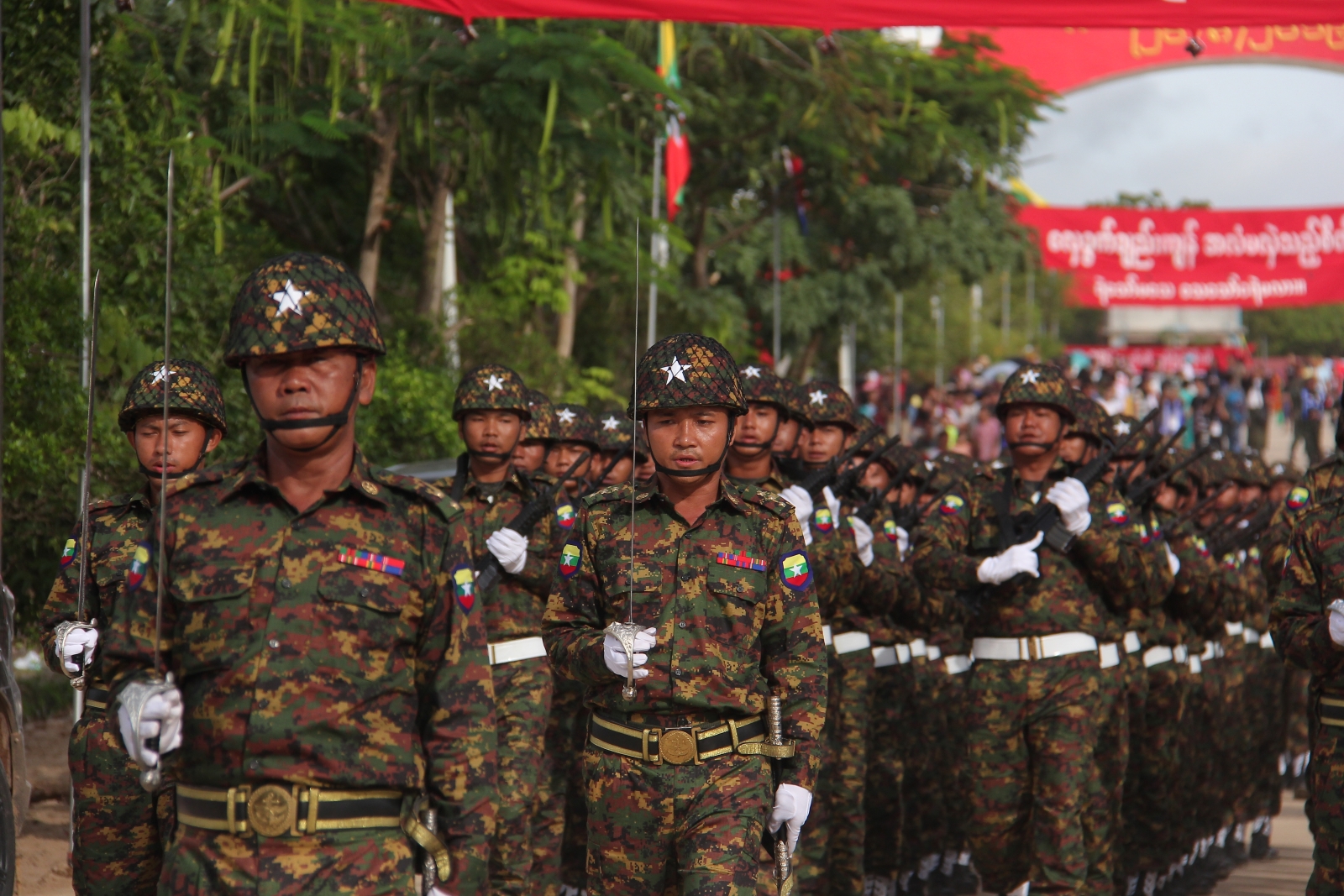While fighting has subsided around the Kayin State town since fierce clashes in 2021, displaced residents are unable to return home because the area is sown with landmines planted by both the military and its opponents.
By FRONTIER
Cleaner Naw Thuzar Htay* was sweeping the yard in front of a client’s house in Kayin State when she tossed a bag of rubbish over a brick wall. On landing, the bag triggered a huge explosion that knocked her unconscious.
Though the wall shielded most of Thuzar Htay’s body, the explosion broke her lower jaw, knocked out almost all of her front teeth and she lost hearing in her right ear.
It was March 15, just a few days after Thuzar Htay, 50, returned to her hometown, Lay Kay Kaw in Myawaddy Township, after spending over a year in the Talaw Tapoh camp for internally displaced people. She and her family were among the thousands forced to flee when fierce fighting broke out in December 2021 between the Tatmadaw and resistance forces led by the Karen National Liberation Army, the armed wing of the Karen National Union.
In the aftermath of the February 2021 coup, Lay Kay Kaw, which was administered by the KNU’s Brigade 6, became a safe haven for dissidents fleeing the junta’s repression. During the 2021 raid, the military captured dozens of high-profile political prisoners, including two lawmakers from the overthrown National League for Democracy, and drove KNLA forces from the area.
Fighting has subsided but returning to Lay Kay Kaw remains rife with danger. Observers say both the military junta and pro-democracy armed groups have planted landmines in the area, which can continue causing civilian casualties for years, or even decades, after fighting stops.
“I don’t dare leave my house anymore because I’m afraid of landmines. That’s why I would discourage anyone from returning here,” said Thuzar Htay. After the explosion, she spent over two months at Mae Sot Hospital in Thailand, where she had a steel rod attached to her lower jaw, and now can only eat rice gruel.
It’s unclear who planted that landmine.
The Karen Human Rights Group documented 38 incidents where landmines or unexploded ordnances detonated in Kayin State alone between the coup and July 21, leaving 13 civilians dead and 34 injured, but said the true figure is likely much higher. Unexploded ordnances, or UXOs, are explosive devices that have been primed for use but didn’t go off as originally intended.
“Rockets, rifle-grenades, missiles and mortars will all leave a certain percentage of unexploded but fragile and lethally dangerous live munitions in the field,” explained Mr Yeshua Moser-Puangsuwan, a researcher with the International Campaign to Ban Landmines. “The percentage will go up if the ordinance is improvised.”
Many of the weapons used by resistance groups formed in opposition to the coup, known broadly as People’s Defence Forces, are improvised out of necessity.

A longstanding scourge
Landmines, UXOs and explosive remnants of war pose grave risks during conflict and remain a sinister, lurking danger after fighting has ended. They have long posed a threat to residents across Myanmar’s restive border areas, but the problem has escalated since the coup.
Moser-Puangsuwan said his organisation has registered 5,629 landmine casualties from 1999 to the end of 2021, with 1,008 killed, 4,500 injured and 121 victims with an unknown survival outcome.
He added that recent fighting has resulted in a “significant increase in contamination by landmines and explosive remnants of war in areas previously free of contamination”.
Data is still being collected for 2022, but UNICEF Myanmar said in May that nationwide, landmines and ERW killed 82 civilians and injured 306 between January and April this year, and 21 percent of the victims were children.
Tellingly, the report said that Sagaing Region accounted for the most casualties with 38pc of the total. Before the coup, the area had been conflict-free for decades, but since then it has been the site of some of the most intense fighting.
Moser-Puangsuwan said there is no official mechanism in the country to record incidents involving landmines, UXOs and ERWs and no armed group provides information about landmine casualties in their areas of operation.
“No health department provides such data. All current statistics should be considered partial and the true number is much, much higher,” he said.
Myanmar is among just a few countries – including China, India, Iran, Israel, North Korea, Russia and the United States – that have not signed the 1997 convention banning the use of anti-personnel mines, known as the Ottawa Treaty.
Tatmadaw defector Captain Phyo Thet Maung* said it was likely that the military had increased the use of landmines since the coup because they see it as an effective way of deterring enemies.
He explained the military mainly uses M-14 landmines, which can blow off a victim’s foot at the ankle, and more powerful MM-2s, which take off a leg at the knee. Both types of landmines are made by the Myanmar Directorate of Defence Industries, the military’s main weapons manufacturer, also known as Ka Pa Sa.
Organisations working on landmines in Myanmar said the military and ethnic armed groups that are signatories of the Nationwide Ceasefire Agreement are supposed to work together in mine clearance operations as part of the truce.
However, “neither the military nor signatories of the NCA have engaged in widespread landmine clearance,” said a member of an international NGO working on raising risk awareness who asked to withhold his name and his organisation.
Furthermore, since the coup, three of the 10 NCA signatories, including the KNU, have stopped cooperating with the military and are openly allied with the pro-democracy uprising to overthrow the regime.
Used by all sides
Multiple observers said the use of landmines is increasingly rapidly across Myanmar, employed by both junta forces and pro-democracy armed groups.
“Karen [Kayin] State has long had a landmine problem,” said Saw Nanda Hsue, an advocacy coordinator at KHRG. “Previous landmine clearance work wasn’t completed. Since the coup, landmines have been used by the Myanmar military and many other armed groups and have had a negative effect on the safety of communities.”
Those “many other armed groups” include PDFs and ethnic armed groups allied both to the resistance and the military junta.
Nanda Hsue said KHRG has evidence that the KNLA and the junta-aligned Kayin State Border Guard Force use landmines, and says it can be “assumed” PDFs do as well, but they don’t have “direct evidence”.
Moser-Puangsuwan said the PDFs and other armed groups also use Tatmadaw-produced landmines they’ve seized from the military.
“In addition we have documented the production of improvised antipersonnel landmines by many groups,” he said.
An officer in a PDF battalion operating under the guidance of the Kawthoolei Army said they routinely use M-14 landmines, stake mines and claymore mines.

“We can use them only after getting approval from the [KTLA] battalion commander,” he said, adding they usually report the mines’ location to other armed groups operating in the area, like the KNLA.
“Local authorities then block the road to prevent villagers from traveling to the mine site,” he added.
The KTLA split from the KNU after its commander admitted his troops massacred over 20 men in 2021, claiming the victims were military spies, though KNU officials say they included civilians.
An officer in the Karenni Nationalities Defence Force, a post-coup armed group operating in neighbouring Kayah State, also admitted to Al Jazeera last year that they regularly use landmines. He similarly said they warn civilians to avoid accidental casualties.
But Moser-Puangsuwan said any attempt to use landmines in a targeted fashion is misguided.
“Landmines are an uncontrollable weapon. Once it is laid, the armed group has no further control over it and it will kill or maim the next person or animal which encounters it,” he said. “The short term military use of the weapon is minimal – it might stop an attacker the day it was laid, but then it remains and the long term consequences outweigh its short term possible military usefulness, if any.”
No safe way back home
About 4,000 people lived in Lay Kay Kaw before the coup, and most remain displaced and in fear of returning home. IDPs at the Ler Khaw camp estimate that only about 1,000 residents have returned to the town.
“I will not return until the town is cleared of mines and there is a guarantee that there will be no more fighting there,” said Naw Phaw Wah* a former teacher from Lay Kay Kaw who is sheltering at the Ler Khaw IDP camp.
For now, she says she doesn’t dare.
“Lay Kay Kaw is a battlefield and there is always a risk of landmines in every battlefield,” said a member of the international NGO working on risk awareness. “Clashes occur often and there will be many landmines planted by armed groups.”
A resistance fighter from Yangon who now lives in the KNU Brigade 6 area alleged to Frontier that the military had planted many landmines in two wards of the town.
“Some ward administrators have returned,” he said, adding that although regime forces, including the BGF, might have cleared some landmines, they would not be able to remove all the explosive devices planted in the town.
The administrators, which locals say are under the KNU’s authority, told Frontier mine clearing is underway but declined to elaborate.
“It’s not easy to get access to Lay Kay Kaw because it’s a conflict area,” said a mine risk education facilitator from a local NGO. He added that ethnic armed groups also planted landmines, and have refused to share where they are, supposedly for security reasons.
Moser-Puangsuwan said landmines make it difficult for IDPs to return home because they contaminate fields and forests, which can result in urban migration and the impoverishment of rural communities.
“Also, we cannot identify safe areas since there is ongoing conflict – any area which is free of contamination today may not be tomorrow,” he added.
* indicates use of a pseudonym for security reasons







